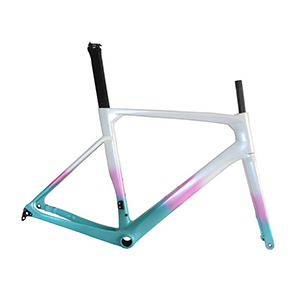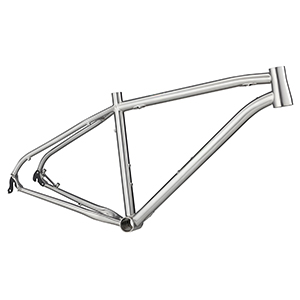
Titanium Vs Carbon Road Bike Frame
Choosing the right road bike frame can greatly affect how your bike feels and performs. Two of the most popular materials are titanium and carbon fiber. Each has its own strengths, weaknesses, and riding style.
In this guide, we’ll compare titanium vs carbon road bike frames in terms of weight, comfort, durability, and overall value. By understanding the key differences, you can pick the frame that best matches your riding style and long-term needs.
What is a Carbon Bike Frame?
Now that we’ve introduced the importance of choosing the right frame, let’s take a closer look at carbon fiber bike frames. Known for their lightweight and performance-oriented design, carbon frames are a popular choice for road cyclists and racers alike.

What is a Titanium Bike Frame?
After exploring carbon frames, let’s examine titanium bike frames. Titanium is celebrated for its strength, durability, and long-lasting comfort, making it a top choice for riders seeking a reliable and smooth ride.
Understanding the material and construction process highlights why titanium frames are often preferred for custom, high-end bicycles.

Benefits and Drawbacks of Carbon Bike Frames
Benefits of Carbon Fiber Bike Frames
Lightweight: Carbon frames are among the lightest, making climbing and acceleration easier.
Responsive Handling: The stiffness allows precise control and quick power transfer.
Comfortable Ride: Carbon can be engineered to absorb road vibrations, providing a smoother experience.
Design Flexibility: Manufacturers can mold complex shapes, optimizing aerodynamics and aesthetics.
Easier Repairs: In some cases, damaged carbon sections can be professionally repaired, unlike metal frames.
Drawbacks of Carbon Bike Frames
Lower Durability: Carbon is less resistant to impact than titanium or steel.
Shorter Lifespan: Frames may need replacement sooner, especially under heavy use.
Cost Considerations: High-end carbon frames can be expensive upfront.
Limited Load Capacity: Attaching racks or panniers is often difficult due to the frame design.
Environmental Impact: Carbon is not fully recyclable, unlike metals.
Understanding these benefits and drawbacks allows cyclists to weigh performance versus longevity, helping identify if carbon is the right choice for their specific needs.
Benefits and Drawbacks of Titanium Bike Frames
Benefits of Titanium Bike Frames
Durable and Long-Lasting: Titanium resists corrosion and fatigue, often lasting a lifetime.
Comfortable Ride: The metal naturally flexes to absorb road vibrations, reducing rider fatigue.
Strong yet Lightweight: Although slightly heavier than carbon, titanium provides an excellent strength-to-weight ratio.
Environmentally Friendly: Titanium is recyclable and more sustainable than carbon composites.
Timeless Aesthetics: Handcrafted titanium frames often have a polished, classic look that appeals to enthusiasts.
Drawbacks of Titanium Bike Frames
Higher Production Cost: Crafting and welding titanium is labor-intensive, increasing the price.
Difficult to Repair: Damage requires specialized welding, making field repairs challenging.
Slightly Heavier than Carbon: Extra weight may affect competitive racing performance.
Limited Design Flexibility: Unlike carbon, complex shapes and aerodynamics are harder to achieve.
Manufacturing Process: Titanium Welding vs Carbon Fiber Molding
Both materials require precision, but the techniques vary significantly, affecting durability, weight, and customization possibilities.
|
Process Aspect |
Titanium Welding |
Carbon Fiber Molding |
|
Material Preparation |
Titanium tubes are cut, shaped, and prepared for welding. |
Carbon fiber sheets are cut and oriented in layers for strength. |
|
Joining Method |
High-precision welding (TIG or TIG with hand finishing) is used to fuse tubes. |
Layers are bonded with resin and cured, often in molds or autoclaves. |
|
Customization Flexibility |
Limited by tube shapes and welding capability, complex aero shapes are challenging. |
Highly flexible; tubes and frames can be molded into intricate designs for aerodynamics and stiffness. |
|
Durability & Longevity |
Extremely strong joints; resistant to fatigue and corrosion. |
Layer orientation affects stiffness and durability; impact damage may require specialized repair. |
|
Production Speed |
Labor-intensive and slower due to handcrafting. |
Faster for batch production, though high-end one-piece molds take time. |
|
Finish & Aesthetics |
Polished or brushed titanium retains a timeless look. |
Sleek, smooth finish; allows for varied colors, decals, and integrated designs. |
|
Feature |
Titanium Bike Frames |
Carbon Bike Frames |
|
Weight |
Slightly heavier, typically 1–1.5 kg for a frame. |
Extremely lightweight, often 0.9–1.2 kg per frame. |
|
Stiffness |
Moderate stiffness with natural flex; absorbs road vibrations. |
Highly stiff in targeted areas; maximizes pedaling efficiency. |
|
Power Transfer |
Smooth and consistent, slightly less aggressive than carbon. |
Very efficient, power is transmitted directly to the drivetrain. |
|
Ride Responsiveness |
Balanced, forgiving on rough surfaces. |
Immediate response, ideal for sprinting and racing. |
Price Comparison & Long-Term Value
Following the discussion on durability, it’s important to consider how much each frame costs and what value you get over time. Choosing between titanium and carbon isn’t just about the price tag—it’s about long-term ownership.
Titanium bike frames usually cost more upfront. The reason is simple: high-quality alloys, precise welding, and careful craftsmanship take time and skill. However, this initial cost is offset by titanium’s longevity. A titanium frame can last for decades, meaning fewer repairs and replacements, making it a solid investment in the long run.
Carbon bike frames can be less expensive at first, especially entry-level models. High-end carbon frames, designed for racing or performance, can be just as pricey as titanium. While carbon is strong and lightweight, it’s more vulnerable to impacts and may need repairs or replacement sooner, which adds to the long-term cost.
Performance in Different Riding Conditions
It’s important to understand how titanium and carbon frames perform in various riding conditions. Not every frame behaves the same on smooth roads, gravel, or long climbs.
Titanium bike frames are known for their versatility. They absorb vibrations well, providing a smooth and comfortable ride on rough roads or gravel trails. Their durability also makes them reliable in changing weather or long-distance rides. Riders can enjoy consistent performance, whether on daily commutes, touring trips, or weekend adventures.
Carbon bike frames, meanwhile, excel in lightweight performance and stiffness. They are ideal for racing and fast climbs, where power transfer and responsiveness are critical. However, carbon frames can be less forgiving on rough surfaces, as they transmit more road vibrations to the rider. Extra care is needed to avoid impacts that might damage the frame.
Aesthetic Appeal & Customization Options
Both titanium and carbon frames offer unique visual and customization advantages, allowing riders to choose a bike that matches their style and needs.
Carbon: Shape Freedom and Aero Integration
Carbon frames provide unmatched freedom in design. Because carbon can be molded into complex shapes, manufacturers can create aerodynamic tubes, integrated cable routing, and lightweight structures without compromising strength. This flexibility also allows for eye-catching designs and color combinations, making each carbon bike visually striking while optimizing speed and performance.
Which Frame Material Fits Your Riding Style?
Choosing between titanium and carbon depends on the type of cycling you enjoy and the terrain you ride most often.
Titanium bike frames are ideal for riders who prioritize comfort, durability, and long-term reliability. They excel on rough roads, long-distance tours, gravel adventures, and everyday commuting. If you want a bike that can handle varied conditions without frequent repairs, titanium is a smart choice.
Carbon fiber bike frames, on the other hand, suit cyclists focused on speed, responsiveness, and performance. They are perfect for racing, fast climbs, or smooth paved roads where every gram of weight and stiffness matters. Carbon allows more flexibility in shaping and aerodynamic features, making it a favorite for competitive riders.
Ultimately, the decision comes down to your priorities: titanium offers a smooth, long-lasting ride with classic appeal, while carbon delivers lightweight performance and modern design.
Catégories
Nouveau blog
droits dauteur © 2025 Top-Fire Carbon Technology Co., Ltd. Tous les droits sont réservés. Mettre au courant

Réseau IPv6 pris en charge